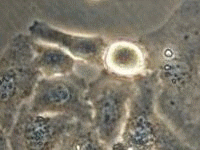The upside of chemotherapy is that it attacks cancer cells and kills them. The downside – and a steep downside it is – is that it is composed of highly toxic compounds that attack other cells of the body, too, resulting in any number of harmful side effects, from anemia to hair loss to nausea and vomiting.
The question concerning researchers is how do we deliver chemotherapy drugs to the harmful cells and leave the healthy cells alone?
Marek Romanowski, Ph.D. associate professor of biomedical engineering at the UA College of Engineering and member of the BIO5 Institute and the Arizona Cancer Center, and his team might be on to an answer. In a paper authored by primary investigator Sarah Leung, along with Xenia Kachur, Michael Bobnick and Dr. Romanowski, Leung describes an idea that is literally golden.
Chemotherapy drugs are sometimes delivered via microscopic capsules called liposomes made of organic lipids already present in cells. These lipid casings, used in a technique called liposomal therapy, do two things. First, they allow the drugs to more effectively penetrate into cancer cells. At the same time, they keep the body’s immune system from eliminating the drugs before they can do their jobs.
The problem is that, as the liposomes degrade, the drugs are potentially released indiscriminately throughout the body. So, how can we force these capsules to release their contents only around those unhealthy tumor cells?
Romanowski and his team are experimenting by coating liposomes with gold, an element which has the property of converting infrared light into heat.
“The heat causes the liposome to become leaky, and then whatever’s really concentrated inside can diffuse out through the liposome,” says Kachur, a third-year graduate student in the Biomedical Engineering Graduate Interdisciplinary Program.
The idea works because infrared light has the ability to penetrate deeply through the body.
“Once you know where the tumors are, you can go ahead and point your light source toward those areas. Whatever else is left will leave the body or may be slowly released, but not to as high or as toxic of levels as it would be if you just injected the drug systemically,” said Leung, a fourth-year graduate student.
One last bonus to the proposed innovation is that the kidneys can naturally filter and eliminate the biodegraded gold nanostructures from the body.
If successful, the gold-coated liposomes being developed at the UA could offer a new way to target delivery of drugs to cancerous regions of the body, non-invasively trigger the drugs’ release using infrared light, and provide a way for the body to naturally eliminate the toxic byproducts.
One day, building on the bold work being done by Marek Romanowski and his students, those suffering cancer may be able to receive effective chemotherapy treatment, confident that they will not have to endure the side effects. To a patient facing such treatments, such confidence will be as good as gold.
Related articles
- Bold Medicine, Golden Innovation (nanotech-now.com)

